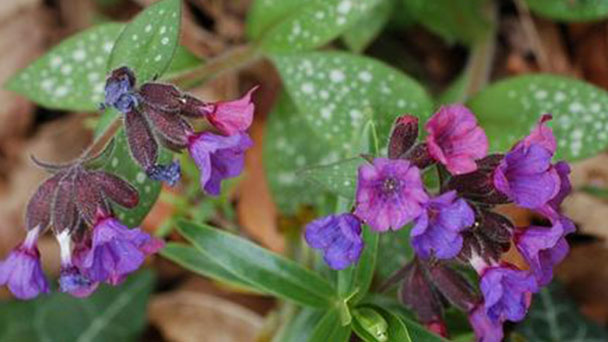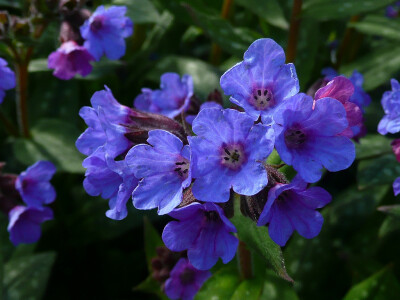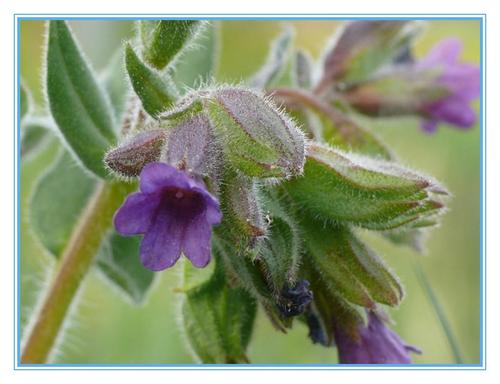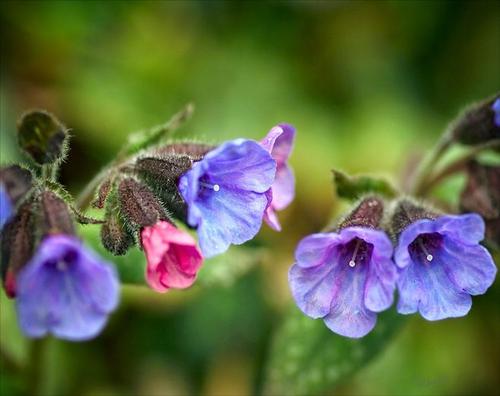Lungwort (pulmonaria) profile
Written by Maggie
Apr 02 2021

Lungwort (pulmonaria) is a hardy evergreen perennial, native to Western Asia and Europe. The shape of the leaf is similar to that of the lung, which is the Latin word for lung. In the rosette of leaves, the leaves are nearly ovate, and the color of the leaves in green has vitiligo. Spring and bloom, reconvening funnel-shaped flowers with white or blue, peach-colored scorpion shaped peduncles in summer, and extending from the apex.
Lungwort picture

Lungwort info
| Botanical Name | Pulmonaria spp |
| Common Names | Lungwort, pulmonaria |
| Plant Type | Herbaceous, perennial |
| Sun | Part shade to full shade |
| Hardiness Zones | 3–8 (USDA) |
| Flower color | Blue, pink, white |
| Native Area | Europe, Asia |
| Mature size | 6–12 in. tall, 12–18 in. wide |
Lungwort morphological characteristics
Lungwort is a perennial herb, with long bristles. Stem is few branches. Basal leaves are large, petiolate; Cauline leaves are alternate. Inflorescences are with bracts falcate; Flowers are pedunculate; Calyx is campanulate, 5-lobed, fruit enlargement, enclosing nutlets; Corolla is purplish red or blue, tube as long as calyx, eaves spreading, 10 -- 15 mm in diam., 5-lobed, throat without appendages or with short hair tufts; Lungwort has 5 stamens, internal, filaments very short, anthers oblong; Ovarian is 4-lobed, style filamate, stigma capitate, 2-lobed; Pistil basal level. Nutlets are ovate, black, shiny, ventral longitudinally keeled, apex obtuse, with a growing face at base of nutlets, slightly concave, with a ring-like margin.
Lungwort distribution
Lungwort has about 5 species, distributing in Central Asia to Europe.
How to grow and care for Lungwort
Light
Lungwort is generally grown in partial solar to full shade. But it can tolerate pretty a bit of vibrant mild in the early spring, which is useful because now not as many timber have leafed out at that factor to diffuse daylight hitting the lungwort. However, harsh direct solar in a warm climate can wilt the plant and scorch its leaves. But too good a deal colour can limit the plant's blooms.
Soil
Lungwort flowers select to develop in organically rich, humus soil. The soil additionally needs to have right drainage. The plant life selects a barely acidic to impartial soil pH however can tolerate barely alkaline soil as well.
Water
Lungwort wants an average quantity of moisture and conflict in soil that is too dry or too wet. Water on every occasion the soil starts to dry out due to a lack of rainfall and/or especially warm weather. But don’t overwater to the factor that the plant is sitting in soggy soil for an extended period.
Temperature and humidity
Lungwort flora thrive in slight temperatures and have a tendency to fight in hot, humid climates. They begin developing as quickly as the risk of frost has exceeded in the spring. Hot summer season climate may motivate them to wilt; however, they must perk up once more as soon as the cooler temperatures of fall arrive.
Fertilizer
Lungworts do not require universal or heavy fertilization. In the early spring, sprinkle a small quantity of all-purpose backyard fertilizer round the plant. Mixing compost into the soil also can assist to promote wholesome growth.
Pruning
After lungwort is completed flowering for the season, the flower stalks flip brown and flop over, and the older leaves additionally commence to seem to be tattered. Removing the whole flower stalk and the degraded leaves will motivate the plant to rejuvenate with sparkling growth. You additionally can prune off leaves that degrade from mainly warm or dry climate as needed.

Lungwort toxicity
All components of lungwort vegetation include more than one chemical substance that is poisonous to human beings and animals when ingested.3 The leaves additionally usually have tiny coarse hairs that can reason infection through pores and skin contact.
Symptoms of poisoning
Symptoms of poisoning from ingestion in each human being and animals consist of nausea, vomiting, diarrhea, loss of appetite, lethargy, and neurological issues.3 Symptoms from pores and skin contact encompass itchiness, rash, and redness. Contact a scientific expert as quickly as feasible if you suspect poisoning.
Propagating lungwort
Because most present day Pulmonaria sorts are hybrids, they are now not normally started out from seed. Instead, most propagation happens from division. After a mature plant is finished flowering, cautiously dig it up whilst maintaining the roots intact. Gently pull aside the clump, keeping apart the roots. Then, replant the clumps at any place you'll like.
Lungwort varieties
There are numerous species and types of lungwort, including:
Pulmonaria 'Excalibur': A clump formed with silver leaves and long-lasting violet-blue flowers.
Pulmonaria officinalis 'Sissinghurst White': This plant has long, speckled leaves with light crimson buds that open to pure white blooms.
Pulmonaria 'Spilled Milk': This hybrid has the acquainted red to blue flowers. Young leaves are tinged purple, altering to white as they age.
Pulmonaria 'Roy Davidson': This plant has dark green leaves with silver-white spots; the plants are faded blue.
Pulmonaria 'Smokey Blue': This plant has silvery noticed foliage with red plants that flip blue.

Latest Updated
- Benefits of Bugleweed - 7 Science-backed Health Benefits
- Bugleweed Dangers & Side Effects - Is It Poisonous?
- How to Plant Evergreen Trees - What You Should Know
- When to Plant Evergreens - Grow Guide for Evergreen Trees
- 12 Wonderful Evergreen Shrubs for Your Garden
- 12 Popular Evergreen Plants with Pictures for Beginners
- When And How To Prune A Lilac Bush Like a Pro
- How to Grow & Care for Lilac Vine (Hardenbergia Violacea)
- Japanese Lilac Tree (Syringa Reticulata) Care & Propagation Guide
- Shumard Oak Pros and Cons - What to Know
Popular Articles
- Winter maintenance of Antirrhinum Majus
- How to Grow Terminalia Mantaly Tree
- How to Grow and Care for Crossostephium Chinense
- How to grow Antirrhinum Majus in spring
- Peristeria Elata (Dove Orchid) Profile: Info & Care Guide
- Underwatered Snake Plant (Sansevieria Trifasciata) - Signs And How To Fix
- How to Care for Brazilian Jasmine Plant (Mandevilla Sanderi)
- How to Grow & Care for Graptopetalum Purple Delight in Summer
- Rosa Chinensis (China Rose): Plant Growing & Care Tips
- How to Care for Baby Sun Rose (Aptenia Cordifolia)